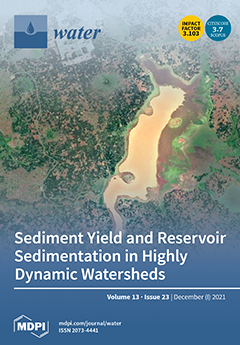In presence of vegetation patches in a channel bed, different flow–morphology interactions in the river will result. The investigation of the nature and intensity of these structures is a crucial part of the research works of river engineering. In this experimental study, the
[...] Read more.
In presence of vegetation patches in a channel bed, different flow–morphology interactions in the river will result. The investigation of the nature and intensity of these structures is a crucial part of the research works of river engineering. In this experimental study, the characteristics of turbulence in the non-developed region downstream of a vegetation patch suffering from a gradual fade have been investigated. The changes in turbulent structure were tracked in sequential patterns by reducing the patch size. The model vegetation was selected carefully to simulate the aquatic vegetation patches in natural rivers. Velocity profile, TKE (Turbulent Kinetic Energy), turbulent power spectra and quadrant analysis have been used to investigate the behavior and intensity of the turbulent structures. The results of the velocity profile and TKE indicate that there are three different flow layers in the region downstream of the vegetation patch, including the wake layer, mixing layer and shear layer. When the vegetation patch is wide enough (
Dv/
Dc > 0.5, termed as the patch width ratio, where
Dv is the width of a vegetation patch and
Dc is the width of the channel), highly intermittent anisotropic turbulent events appear in the mixing layer at the depth of
z/
Hv = 0.7~1.1 and distance of
x/
Hv = 8~12 (where
x is streamwise distance from the patch edge, z is vertical distance from channel bed and
Hv is the height of a vegetation patch). The results of quadrant analysis show that these structures are associated with the dominance of the outward interactions (Q1). Moreover, these structures accompany large coherent Reynolds shear stresses, anomalies in streamwise velocity, increases in the standard deviation of TKE and increases in intermittent Turbulent Kinetic Energy (TKE
i). The intensity and extents of these structures fade with the decrease in the size of a vegetation patch. On the other hand, as the size of the vegetation patch decreases, von Karman vortexes appear in the wake layer and form the dominant flow structures in the downstream region of a vegetation patch.
Full article





